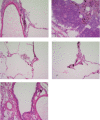Particulate matter air pollution exposure: role in the development and exacerbation of chronic obstructive pulmonary disease
- PMID: 19554194
- PMCID: PMC2699820
- DOI: 10.2147/copd.s5098
Particulate matter air pollution exposure: role in the development and exacerbation of chronic obstructive pulmonary disease
Abstract
Due to the rapid urbanization of the world population, a better understanding of the detrimental effects of exposure to urban air pollution on chronic lung disease is necessary. Strong epidemiological evidence suggests that exposure to particulate matter (PM) air pollution causes exacerbations of pre-existing lung conditions, such as, chronic obstructive pulmonary disease (COPD) resulting in increased morbidity and mortality. However, little is known whether a chronic, low-grade exposure to ambient PM can cause the development and progression of COPD. The deposition of PM in the respiratory tract depends predominantly on the size of the particles, with larger particles deposited in the upper and larger airways and smaller particles penetrating deep into the alveolar spaces. Ineffective clearance of this PM from the airways could cause particle retention in lung tissues, resulting in a chronic, low-grade inflammatory response that may be pathogenetically important in both the exacerbation, as well as, the progression of lung disease. This review focuses on the adverse effects of exposure to ambient PM air pollution on the exacerbation, progression, and development of COPD.
Keywords: air pollution; alveolar macrophage; chronic obstructive pulmonary disease; particulate matter.
Figures



References
-
- Sunyer J, Schwartz J, Tobias A, Macfarlane D, Garcia J, Anto JM. Patients with chronic obstructive pulmonary disease are at increased risk of death associated with urban particle air pollution: a case-crossover analysis. Am J Epidemiol. 2000;151(1):50–56. - PubMed
-
- Pabst M, Hofer F. Deposits of different origin in the lungs of the 5,300-year-old Tyrolean Iceman. Am J Phys Anthropol. 1998;107(1):1–12. - PubMed
-
- Sint T, Donohue JF, Ghio AJ. Ambient air pollution particles and the acute exacerbation of chronic obstructive pulmonary disease. Inhal Toxicol. 2008;20(1):25–29. - PubMed
-
- Hogg JC, Chu F, Utokaparch S, et al. The nature of small-airway obstruction in chronic obstructive pulmonary disease. N Engl J Med. 2004;350(26):2645–2653. - PubMed
-
- Hogg JC. Pathophysiology of airflow limitation in chronic obstructive pulmonary disease. Lancet. 2004;364(9435):709–721. - PubMed
Publication types
MeSH terms
Substances
LinkOut - more resources
Full Text Sources
Medical

